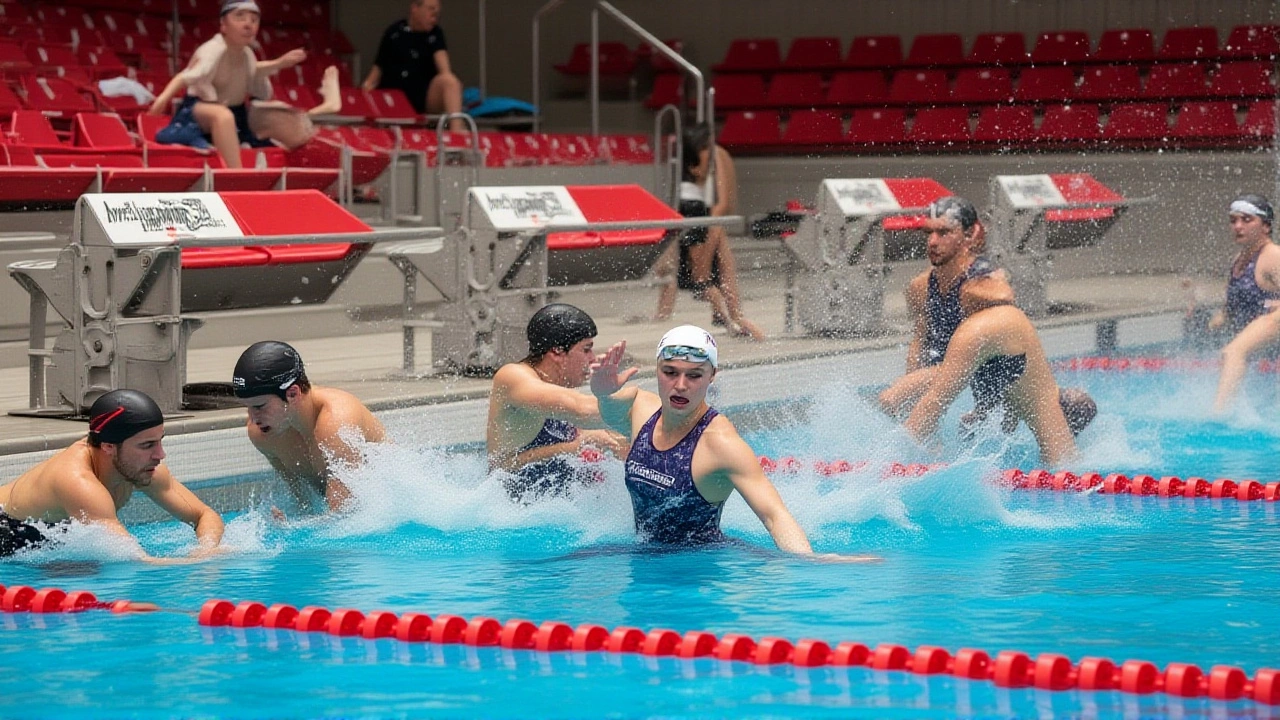After two days of blistering laps and explosive dives, The Ohio State University holds a razor-thin lead at the 2025 Ohio State Fall InvitationalMcCorkle Aquatic Pavilion in Columbus, Ohio. With 850 points, the Buckeyes are just 37.5 points ahead of Indiana University and 49 points ahead of University of Louisville—a margin so narrow it could vanish in a single relay. The meet, running from November 18 to November 21, 2025, isn’t just another midseason tune-up. It’s a pressure cooker for teams eyeing the Big Ten Championships in February and the NCAA Championships in March.
A Battle of Titans in the Pool
Day one delivered chaos. Day two? Pure drama. The women’s team surged ahead with powerhouse performances in the 200-yard freestyle and 400-yard individual medley, while the men’s squad, despite trailing in the team standings, showed flashes of brilliance. Tristan Jankovics, Ohio State’s top seed in the men’s 400 IM, didn’t just swim—he dominated the prelims, clocking a time that had the crowd buzzing. His lead isn’t just personal; it’s strategic. In a season where every tenth of a second matters, Jankovics is setting the tone for what could be a championship-caliber run.
The scoring reflects a field that’s tighter than a swim cap. Purdue University sits fifth with 540 points, while University of California, Los Angeles and University of Kentucky are locked in a fierce battle for fourth and fifth. Even University of Cincinnati, whose score remains incomplete, is clearly in the mix. This isn’t a one-team show. It’s a five-team brawl—and it’s only halfway done.
The New Midseason Format That’s Changing College Swimming
What makes this invitational different isn’t just the competition—it’s the structure. For the 2025-26 season, the NCAA has quietly encouraged schools to adopt a new format for midseason meets: shorter, sharper, and more intense. No more slow-building meets. This is a sprint to the finish, with prelims at 9:30 a.m. and finals at 5:30 p.m. each day. It’s designed to mimic championship conditions, forcing swimmers to recover fast, focus harder, and perform under pressure.
Ohio State isn’t alone in this shift. University of Georgia, North Carolina State University, and University of South Carolina are all running similar schedules. The goal? To weed out the inconsistent and elevate the elite. And right now, Ohio State is proving it can handle the heat.
Behind the Scenes: Training, Timing, and Team Culture
There’s no public quote from head coach or athletes—yet. But the data speaks volumes. Ohio State’s schedule reads like a championship blueprint: an Alumni Meet in October, back-to-back World Cup appearances, a tough dual against Virginia Tech, then the US Open in December. This invitational sits squarely in the middle of it all, like a training camp disguised as a competition. The Buckeyes aren’t just swimming. They’re stress-testing their endurance, their transitions, their mental toughness.
And it’s working. The women’s team leading the pack? That’s no accident. It’s the result of months of early-morning drills, video breakdowns, and a culture that treats every race like a final. The men’s team, sitting third, is clearly building toward something bigger. They’ve got the speed. Now they need the consistency. The next two days will show whether they can close the gap—or if they’ll be left chasing.

What’s at Stake Beyond the Points
This isn’t just about winning a trophy in Columbus. It’s about momentum. The Big Ten Championships are less than three months away, and seeding matters. A strong showing here can boost confidence, secure relay spots, and send a message to rivals. For schools like Indiana and Louisville, this invitational is a litmus test: Can we beat Ohio State when it matters? For Ohio State, it’s a mirror: Are we ready for what comes next?
The McCorkle Aquatic Pavilion, home to the Buckeyes since 2001, is buzzing with energy. Parents, alumni, recruits—all watching. The pool’s blue tiles reflect more than just water. They reflect ambition. And on Friday night, when the final relay ends, someone will walk away knowing they’ve earned more than points—they’ve earned belief.
What’s Next?
With two days left, the race is wide open. The 100-yard butterfly, 200-yard backstroke, and 4x100-yard medley relay loom large. If Indiana’s sprinters can flip the script, or if Louisville’s divers deliver a surprise surge, the standings could shake up entirely. Ohio State’s lead is real—but it’s fragile. Every stroke counts. Every turn matters. And in college swimming, the best teams don’t just win races—they win mental battles.
Frequently Asked Questions
How does the new NCAA midseason format impact team strategy?
The new format compresses competition into daily prelims and finals, forcing athletes to recover quickly and perform under tournament-like pressure. Teams can’t afford to pace themselves—they must peak twice a day. This mimics Big Ten and NCAA conditions, making these invites critical for identifying who can handle the grind. Ohio State’s coaching staff has used this to test relay rotations and individual endurance ahead of February’s conference championships.
Why is Tristan Jankovics’ performance in the 400 IM significant?
Jankovics entered the event as the top seed and delivered a time that puts him in contention for All-American honors. His performance signals Ohio State’s depth in middle-distance events, which are often decisive in team scoring. If he maintains this form through the Big Ten and NCAA meets, he could be the difference-maker in close team battles, especially since the 400 IM is worth 20 points in dual scoring.
Which teams are most likely to challenge Ohio State for the overall title?
Indiana University and the University of Louisville are the top threats. Indiana’s strength in freestyle sprints and relays could close the 37.5-point gap, while Louisville’s depth in diving and individual medleys gives them scoring potential in events Ohio State hasn’t dominated yet. Purdue and UCLA could also surge if their backstroke and butterfly specialists deliver standout performances in the final two days.
How does this meet affect NCAA Championship seeding?
While invitational results don’t directly impact NCAA seeding, they heavily influence selection committee perceptions. Strong performances here—especially in events like the 400 IM, 200 fly, and relays—can elevate individual swimmer profiles and boost team rankings. Ohio State’s early lead signals they’re a top contender, while Indiana and Louisville’s close pursuit suggests they’re also in the conversation for top-10 national finishes.
What role does the McCorkle Aquatic Pavilion play in Ohio State’s success?
Home advantage is real. The McCorkle Aquatic Pavilion, with its intimate crowd capacity and acoustics that amplify cheers, creates an intimidating atmosphere for visiting teams. Ohio State athletes train here daily, so they’re accustomed to the lighting, water temperature, and even the echo off the walls. For visiting swimmers, it’s not just a pool—it’s a psychological challenge. That edge could be the difference in tight races.
When will the final team standings be official?
Final standings will be confirmed after the last event concludes on Friday, November 21, 2025, at approximately 7:00 p.m. ET. Official results will be posted on ohiostatebuckeyes.com and distributed through the NCAA’s official results portal. Live updates are also being streamed on Ohio State’s YouTube channel and Instagram, with post-race interviews expected to drop within hours of the final bell.

